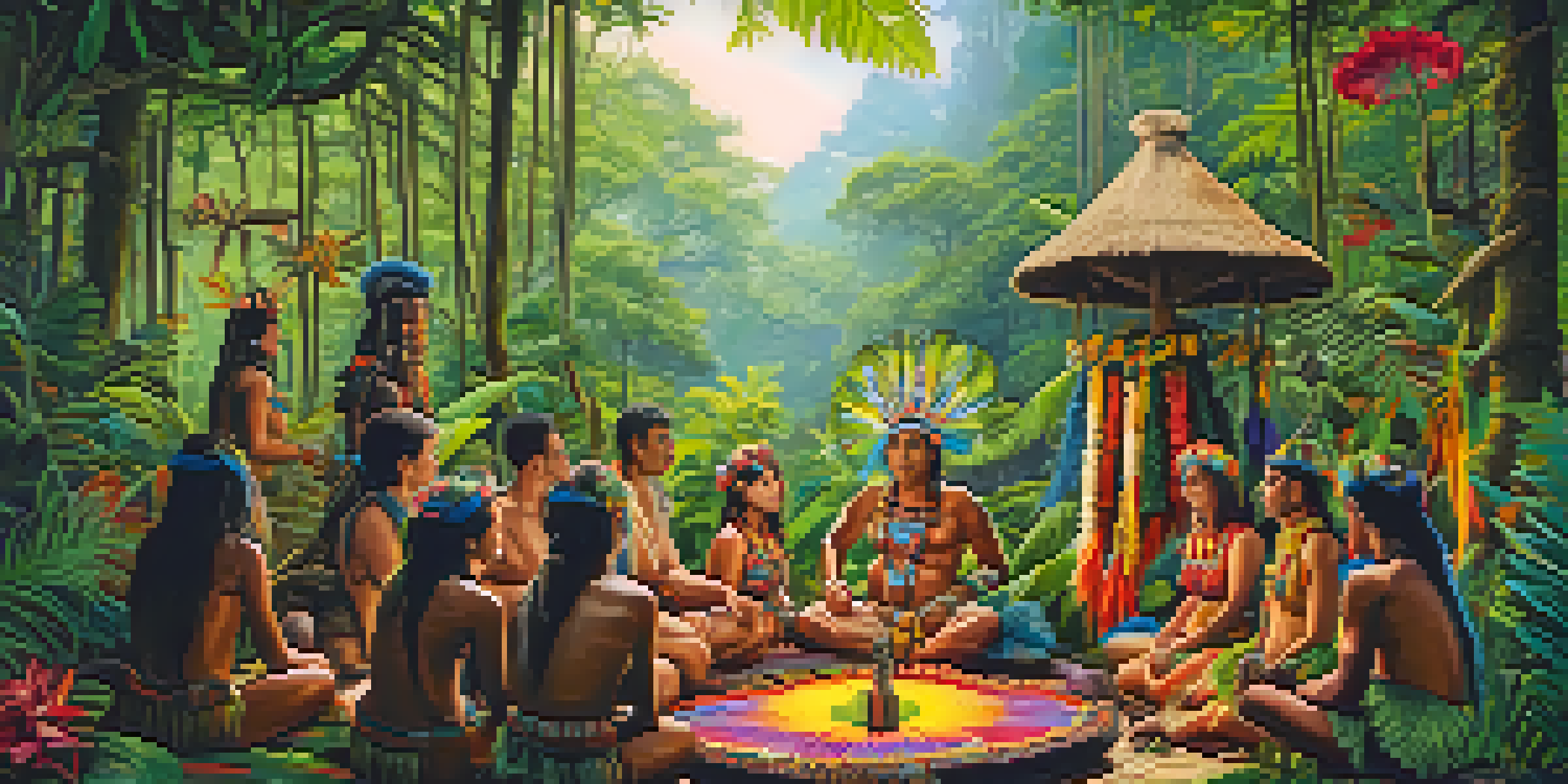Cultural Significance of Hallucinogens in Different Societies

Understanding Hallucinogens and Their Uses
Hallucinogens are substances that alter perception, mood, and cognitive processes. They have been used by various cultures for centuries, often in spiritual or healing contexts. From the ancient rituals of indigenous tribes to modern therapeutic practices, these substances hold a significant place in many societies.
Psychedelics can help us understand how our thoughts and feelings are connected to our body and our environment.
In many cases, hallucinogens are not merely recreational; they are integral to cultural identity and spiritual practices. For instance, psychedelics like peyote and psilocybin mushrooms are often used in ceremonial settings, facilitating connections with the divine or the community. This bridges the gap between the physical and spiritual worlds, as participants seek deeper understanding of themselves and their surroundings.
Thus, understanding hallucinogens requires a look beyond their chemical properties to their profound cultural implications. They serve as tools for exploration, healing, and communal bonding, showcasing the rich tapestry of human experience across different societies.
Historical Context of Hallucinogens in Ancient Cultures
Many ancient cultures utilized hallucinogens in religious ceremonies and healing practices, with evidence dating back thousands of years. For example, the use of the Amanita muscaria mushroom in Siberian shamanism illustrates the long-standing belief in the power of these substances to induce altered states of consciousness. Such practices often aimed to gain wisdom or insight from the spirit world.

Similarly, the ancient Greeks incorporated the use of hallucinogenic substances in their Eleusinian Mysteries, which were secretive rituals held in honor of Demeter and Persephone. Participants sought to experience profound revelations about life, death, and rebirth, demonstrating the integral role of hallucinogens in their quest for understanding.
Therapeutic Potential of Psychedelics
Recent research highlights the effectiveness of hallucinogens like psilocybin and MDMA in treating mental health issues such as depression and PTSD.
By examining these historical contexts, we can appreciate how hallucinogens helped shape philosophies and spiritual beliefs, laying the foundation for many cultural practices that continue today.
Hallucinogens in Indigenous Practices
Indigenous cultures around the world have long embraced hallucinogens for their spiritual significance. In the Amazon rainforest, for example, the brew ayahuasca is used by various tribes for healing and guidance. This powerful concoction is believed to connect individuals with ancestral spirits, providing insight and direction.
The use of psychedelics in therapy is not about the drug; it's about the experience and the insights that come from it.
The use of hallucinogens in these contexts is often accompanied by rituals that enhance the experience, fostering community bonding and shared understanding. These ceremonies are deeply rooted in cultural traditions, with each tribe having its unique interpretations and practices surrounding the substances.
As these indigenous practices gain recognition globally, they also face challenges from commercialization and cultural appropriation, highlighting the need to respect and preserve their origins.
Modern Therapeutic Uses of Hallucinogens
In recent years, there has been a resurgence of interest in the therapeutic potential of hallucinogens. Research indicates that substances like psilocybin and MDMA may effectively treat mental health issues such as depression, PTSD, and anxiety. This modern approach seeks to harness their transformative effects while ensuring ethical use and informed consent.
Therapists often guide patients through experiences, creating a safe environment for exploration and healing. This structured approach contrasts with recreational use, emphasizing the need for professional oversight to maximize benefits and minimize risks.
Evolving Attitudes Towards Psychedelics
Cultural attitudes toward hallucinogens vary widely, influencing their acceptance and legal status in different societies.
The integration of hallucinogens into contemporary therapy reflects a growing acknowledgment of their historical significance and potential to improve well-being, bridging the gap between ancient practices and modern science.
Cultural Attitudes Towards Hallucinogens
Cultural attitudes toward hallucinogens vary widely across societies, influenced by historical, social, and political factors. In some cultures, these substances are celebrated as sacred tools, while in others, they are stigmatized or criminalized. This dichotomy often reflects broader societal views on mental health, spirituality, and personal freedom.
For instance, in countries like Brazil, ayahuasca is legally recognized and used in religious contexts, while in others, similar substances face harsh penalties. These differing perspectives can lead to tensions, particularly as global interest in psychedelics grows.
Understanding these cultural attitudes is crucial for fostering respectful dialogue and promoting informed policy-making regarding the use of hallucinogens.
The Role of Hallucinogens in Social Movements
Hallucinogens have played a significant role in various social movements, particularly during the counterculture of the 1960s. Many activists embraced psychedelics as tools for expanding consciousness and challenging societal norms. This era saw a blending of spirituality, creativity, and political activism, with hallucinogens often at the forefront of cultural change.
Today, we see a revival of interest in hallucinogens among modern social movements advocating for mental health awareness, environmental sustainability, and social justice. Advocates argue that these substances can foster empathy and connection, encouraging participants to engage more deeply with social issues.
Cultural Significance of Hallucinogens
Hallucinogens have deep historical roots in various cultures, serving as tools for spiritual connection and communal bonding.
The intersection of hallucinogens and social movements underscores their potential for facilitating change, highlighting the importance of their cultural significance beyond personal use.
Future Perspectives on Hallucinogens in Society
As research continues to unveil the potential benefits of hallucinogens, society's relationship with these substances is poised for transformation. Increasingly, people are recognizing their historical and cultural significance, leading to a more nuanced understanding. This shift could reshape policies, encouraging a move toward decriminalization and responsible use.
Moreover, as conversations around mental health become more open, hallucinogens may play a pivotal role in holistic treatment approaches. This evolving perspective invites further exploration of their cultural roots, ensuring that modern applications respect and honor traditional practices.

Ultimately, the future of hallucinogens in society will hinge on our ability to balance respect for cultural heritage with the promise of scientific advancement, creating a space where both can coexist harmoniously.